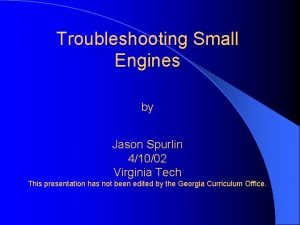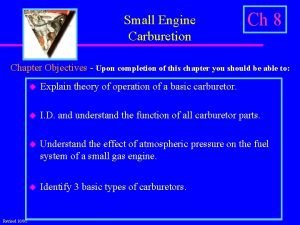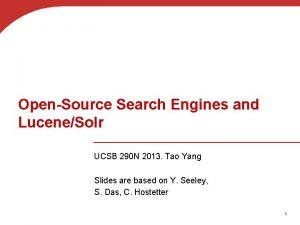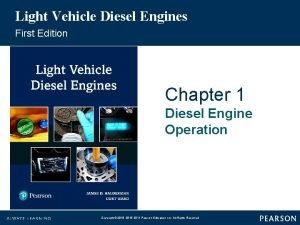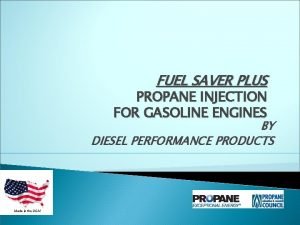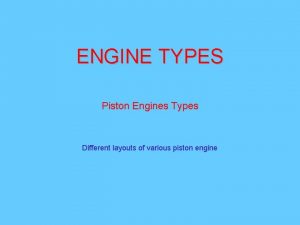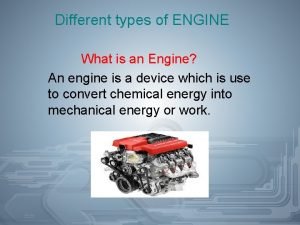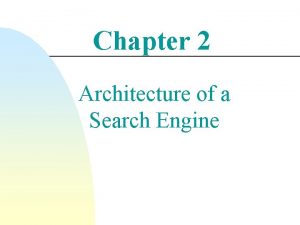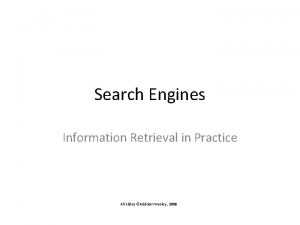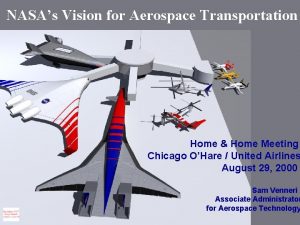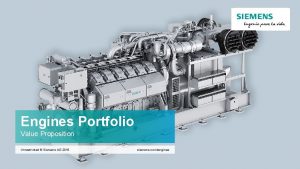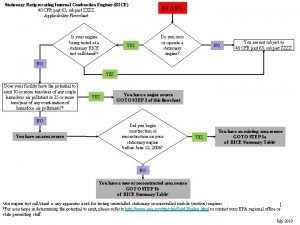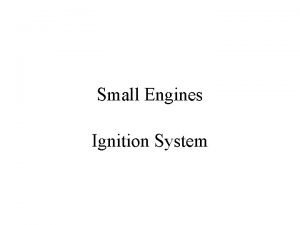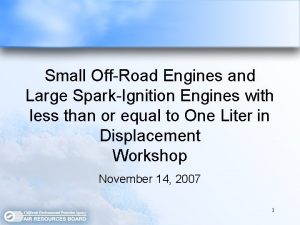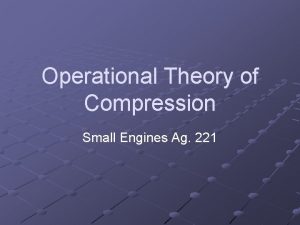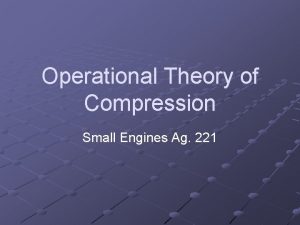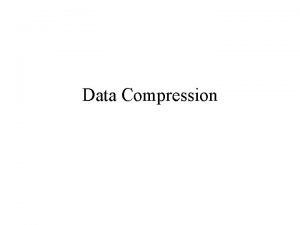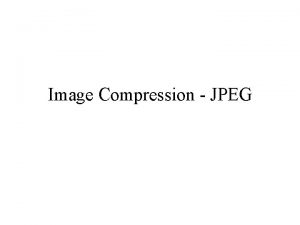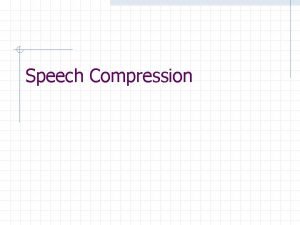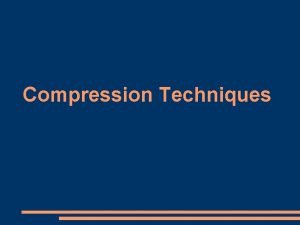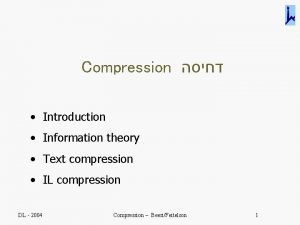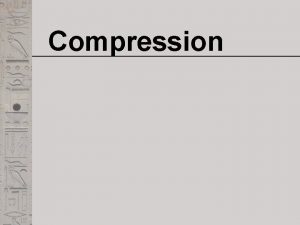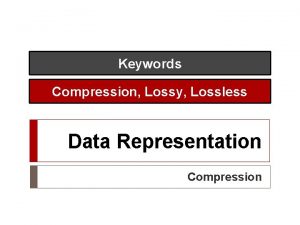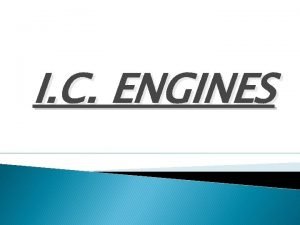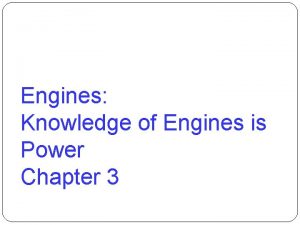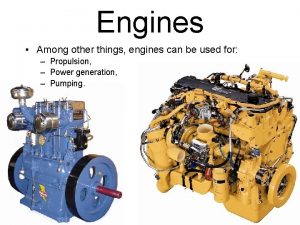Small Engines Compression System Compression System Components Function






















- Slides: 22

Small Engines Compression System

Compression System Components • Function – Components direct, contain, and compress the airfuel mixture, and then discharge the gases

Compression Ratios • Most small engines operate with a compression ratio between 6: 1 to 8. 5: 1

Changes in the Charge • Air-fuel mixture enters the combustion chamber the gas in the mixture is closer to a liquid state. • As the piston moves from BDC to TDC the airfuel mixture is compressed changing the mix to a gaseous state

Changes in the charge • Heat is produced as a byproduct • Larger droplets break down into smaller droplets increasing the total surface area, exposing more liquid gasoline to the air.

Ignition • The energy required to initiate combustion is provided by spark plug. • This is achieved by creating a spark that jumps across the gap in the electrode end of the spark plug.

Compression Problems • Two types of problems with compression • Excessive Compression • Inadequate compression

Inadequate Compression • Most common cause is from leaks • If the leak occurs from the exhaust valve this causes an increase in dilution of the air to fuel mixture

Maverick Air • This undesirable air entering the combustion chamber is called “Maverick Air” • Maverick air could potentially come from a leaking valve • Entering through the exhaust valve from the muffler or bypassing the carburetor and entering through the intake valve.

Excessive Compression • Can lead to detonation and pre ignition of the air-fuel charge • Detonation is the condition of a significant portion of the charge spontaneously combusting before the spark induced ignition • Also known as “knocking” or “pinging”

Detonation • Occurs when the compression ration is increased • This can be caused by carbon build up and deposits • Can lead to potential failures of the piston connecting rod or occasionally crankshaft failures

Pre-Ignition • Caused by a small portion of the combustion chamber becoming excessively heated • Or can also be caused by a particle in the combustion chamber igniting the charge as it enters the combustion chamber. • Can also lead to part failure in the engine.

Valve Dynamics • Most valves in a small engine operate in a circular motion. • This has an positive effect on the overall lifespan of the valve • Also helps by causing a mild scraping action that helps clean the face of the valve

Valve Dynamics • This rotation can be achieved by specially designed cam shafts or other features such as valve springs that create torque on the valve stem

Measurements • Many different measurements are often needed to make sure that parts on a small engine are not becoming excessively worn out. • Two tools are often used in small engine measurements • The Dial Caliper and the Micrometers

Dial Caliper

Dial Caliper • Used to make precise measurements • Several types of measurements can be made with the dial caliper • Outside diameter, length or height, or thickness of a part

Dial Calipers • Used to make precise measurements up to 1000 th of an inch • To make a measurement set the caliper to zero then adjust the tool until the measuring contacts come into contact with the part that you wish to measure

Reading a Dial Caliper • Start by reading the measurement given on the Bar • The bar is given in increments of inches and tenths of inches • Continue by then reading the dial • The dial is given in increments of thousands of an inch

• To get the overall measurement add the measurement from the bar to the measurement from the dial to get the total measurement.

Micrometer

Micrometer • Twist the micrometer tightening knob clockwise until the anvil and spindle are tight against the part being measured • Read the whole numbers on the sleeve first followed by the corresponding numbers on the thimbles.
 Troubleshooting small engines
Troubleshooting small engines Chapter 8 carburetion answers
Chapter 8 carburetion answers Siege engines
Siege engines Gopher search engine history
Gopher search engine history Knowledge search engines
Knowledge search engines Meta search engine definition
Meta search engine definition Open source search engines
Open source search engines Bill nye fuel injector
Bill nye fuel injector Propane injection
Propane injection Types of piston
Types of piston Different types of engines
Different types of engines Edelman engines has 17 billion
Edelman engines has 17 billion Search engine architecture
Search engine architecture Other search engines
Other search engines Search engines information retrieval in practice
Search engines information retrieval in practice Search engine architecture
Search engine architecture Aircraft engines
Aircraft engines Hz121800
Hz121800 Chapter 5 two-cycle and four-cycle engines answers
Chapter 5 two-cycle and four-cycle engines answers Avaya identity engines
Avaya identity engines Sustainable and green engines
Sustainable and green engines Mact zzzz flowchart
Mact zzzz flowchart Slatten racing engines
Slatten racing engines
